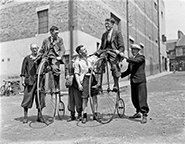“There is a mystery,” the Confederation’s Leader Council would say. “It is a mystery we will never entirely understand. There is something beyond us.” (Allister had understood that even before he joined the World Confederation of Antischolars.) “There is good and bad out there.” (Allister knew that, as well.) “And we have been chosen.” (This, however, was news to Allister- to many new antischolars, in fact.) “We must protect the good from the evil and the evil is mounting. To do this, we must live by the unalterable rules given to us by a higher authority.”
History and science were not needed anymore. Research was not needed anymore. With the extra time, Allister could do anything he wanted, as long as he stayed within the limits of World Confederation of Antischolar guidelines. The world was yours to inherit. And you inherited a new family, as well. The World Confederation of Antischolars became Allister’s family and they protected him and told him what was right and what was wrong (though Allister had learned the difference long ago). And, as busy as everyone was with inheriting the world, learning was made simple. There was only one book. It was thick and written long ago and every word in it was true. So thick and so true, in fact, that there was no room between its covers for cross references or personal anecdotes or other historical facts and lessons. And there was no room for questions.
The antischolars had all that was needed and apparently had always had it, which they still claimed even after new antischolar discoveries were found. From the beginning, they had known the “new discoveries” all along.
The “new discoveries” were only made by the antischolar leaders and (though, not always) tended to add more rules to the lower levels of the antischolar totem pole (which is not an official sign of the World Confederation of Antischolars). But, Allister began to notice that there were leaders who had read much prior to their membership in the Confederation and, what’s more, seemed to continue reading words from the outside world even after joining the Confederation. Those leaders, though they decried monetary wealth, also seemed to be the wealthiest. And, though every antischolar knew that no one would ever know the mystery of the beyond, those leaders suddenly knew the answers. And the answers all seemed to begin with, “Fear.”
And, at first (that is to say, in the beginning), the rules would bend to fit you in and accept you. Even protect you. But, once inside, the rules would bend back and cage you in.
Now, it is important to add that there were certainly leaders (that is to say those at the top of the totem pole (which is not at all affiliated in any way with the World Confederation of Antischolars)) held fast to the traditional tenants and tended to keep to themselves. They were often peaceful people with sage advice. But, in a book so thick and old, it was so easy to find what you wanted, be it peace or be it fear.
Allister, one night while reading the thick old book of the Antischolars, began to question- which was very human and, in turn, very Allister. He began to see that he was being blocked from further thought, from further discovery. He was being blocked from further questions. And it was not the book that was blocking. It was the leaders. It was the confines of their rules. It was the banning of looking outside. Who can ban looking at all? It seemed most important to Allister to look in all directions- be it left, right, front, back, in, or out. Questioning seemed the only way to get to discovery.
And, so, Allister stood up one day at an Antischolar meeting and questioned the leaders. He questioned why they needed to be afraid. He questioned whether the words written in the book were written by a God who was sometimes happy and sometimes vengeful or by men who were sometimes happy or sometimes vengeful with God or their neighbors. And he questioned why they were afraid of new discovery. He questioned why, if God created Earth for them, they inherited only the rewards and none of its problems when so many of the problems they, in fact, helped create? He questioned why you could not question the mistakes of the past and why they insisted, instead, on either stubbornly relying on those mistakes or stubbornly denying that the mistakes ever occurred. He questioned why questioning meant that you did not believe in a higher power. He questioned, with confines so great, how humanity could possibly improve. And he questioned why no one else was questioning.
And when his questions were answered by the threat not to question, Allister left.
But first, he said, "I'm sure there is a mysterious place where science and spirituality meet. But, if we're forbidden to question, we will never find it."


 RSS Feed
RSS Feed